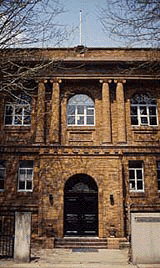
When Kuroda Seiki, often considered the father of modern Western-style painting in Japan, died in 1924, he bequeathed a portion of his estate to be used for the furtherment of art. With this bequest, the Kuroda Memorial Hall was formed in 1928. Within the Hall a room was set aside for the display of works donated by members of Kuroda's family in order to honor his memory. Furthermore, in 1930 the Art Research Institute was established within the same building for the academic study of art and the collection of research materials; this Institute would eventually become the Tokyo Research Institute for Cultural Properties. While the Institute has continued to fulfill its mandate since its foundation, it was moved to a new facility in the year 2000, where it is presently based. It was decided at the same time that the Kuroda Memorial Hall would be located in the former building. As a museum facility designed by Okada Shin'ichiro in the late 1920s, this building was deemed important and has thus been restored to its original appearance. The reopening of the Kuroda Memorial Hall occurred in September 2001. In addition to the original display room, a gallery has been added, allowing for an even greater appreciation of the Hall's collection, which includes 126 oil paintings, 170 drawings, sketchbooks, letters, and so forth.
April 1, 2007, The Independent Administrative Institutions National Museum and National Research Institute of Cultural Properties merged to form the Independent Administrative Institution National Institute for Cultural Heritage. At the same period, Kuroda Memorial Hall was transferred to the Tokyo National Museum.